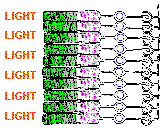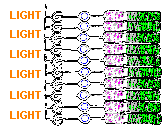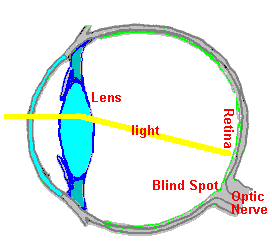|
You probably thought that the best way to position the retina
is with the rhodopsin ends facing into the light. That is the best way to design the eye in order to get the most
sensitivity.
By orienting the layer such that the rhodopsin faces the incoming
light you have designed the eye to be a more sensitive system.
All the nerve cells would be in the back so they would not get
in the way of the incoming light. And the cell's mitochondria
or nucleus wouldn't be in the way either.
| 
|
But the retina is NOT positioned that way. It's positioned backward!
|
The rhodopsin portion is at the back of the retina and
light has to pass through the nucleus, mitochondria and axon before
striking the rhodopsin. Also, the nerve cells that connect to
the rod's axon are in the path of the light so they too block
some light from reaching the rhodopsin. As if that weren't bad
enough, the layer of nerve cells that carry the signal from the
rod's axon is embedded in a matrix (material) that I have not
bothered to include in these diagrams (because it makes the drawing
difficult to interpret).
| 
|
So, the path that light must travel to reach the photosensitive
rhodospin is crisscrossed with nerves and supporting materials
plus the rod's own organelles like mitochondria and nucleus!
Who would design an eye like this?
Certainly not me. Certainly not an engineer or anyone who had
given it a little thought. This back to front arrangement causes
the eye to be less sensitive to light but that is the "plan"
that nature has used.
|
In fact there is another problem with this design.
All those millions of nerve cells conducting signals from the
rods to the brain converge into a signal bundle called the optic
nerve. This bundle acts as the main "cable" that carries
all the millions of nerve paths to the brain. As the nerves along
the top of the retina converge onto this single point their density
becomes so great that no light gets pass them.
This causes a "blind spot" to occur directly over the
optic nerve.
| 
|
If the eye had been designed correctly, with the rodopsin
in the front and the axons and nerves in the back, the nerves
would converge behind everything and there would be no blind spot.
|
Here's a demonstration of the blind spot.
Close your right eye and place your face about a metre from
the screen while looking directly at this black cross. Notice
that you can still see the black circle while staring directly
at the cross. Now, while maintaining your gaze on the cross, slowly
move your face closer to the screen. (Keep your head level and
slowly move forward. It helps if you are sitting in a chair with
wheels.) As you move forward you will see the black circle disappear!
Keep moving closer to the screen and it will reappear again! The
circle appears and disappears as the image moves out of and into
your blind spot.

You can demonstrate the blind spot in your
right eye by closing your left eye and focusing on the circle
with your right eye. Now as you move towards the screen, while
maintaining your stare on the circle with your right eye, the
cross will disappear and reappear. (The effect isn't as striking
as before because the cross isn't the same shape as your blind
spot.)
|
We rarely notice our blind spot for two reasons.
1) We (usually) have two working eyes so objects lost in the blind
spots of one eye are seen by the other eye because the two blind
spots are positioned so they don't overlap. The brain puts the
two images together to make what we interpret as a single seamless
image with no blind spot.
2) We constantly move our eyes, often without thinking about it,
and that helps us to visualize the entire scene. Once again, our
brain interprets it all for us and fills in the missing details.
All vertebrates (from fish to humans) have the retina built the
wrong way around and therefore we all have blind spots.
But why design the eye this way? Well, it wasn't designed at all!
(Sorry Paley.)
Off hand, I don't know why the retina ended up backwards. My guess
is that when the retina was first evolving it was laid down wrong
because even a slight amount of photosensitivity was enough for
our very ancient ancestors who lived in the seas. It was
"good enough" to distinguish between sunshine and darkness
so a sea creature could tell if it were day or night (so it knew when
to feed). Even a badly positioned retina system would allow a
fish to tell if it were entering a cave or if a potential predator
moved over it (blocking out the sun). As the millions of years
went by evolution selected the eye to perform more complex tasks
and true vision came about probably with the evolution of a good
lens. But by that time the backward facing retina was a well-established
"tradition" inherited from the parents and there was
no turning back.
The blind spot and other mistakes (many more than we have time
to discuss) are good evidence that evolution is not perfect. That's
because natural selection doesn't plan for the future nor can
it easily command a major redesign in order to correct an error.
Of course, all this talk about homologous structures, vestigial
organs and mistakes are evidence for Darwinian evolution (Natural
Selection). But there's one more line of evidence we have only
mention briefly.
Can you think of a large body of evidence for evolution we have
yet to discuss in detail?
If you like, you can return to the Home Page.
This work was created by Dr Jamie Love  and
and  licensed under a Creative Commons Attribution-ShareAlike 4.0 International License.
licensed under a Creative Commons Attribution-ShareAlike 4.0 International License.




 and
and  licensed under a Creative Commons Attribution-ShareAlike 4.0 International License.
licensed under a Creative Commons Attribution-ShareAlike 4.0 International License.